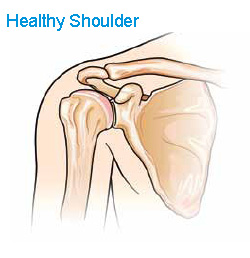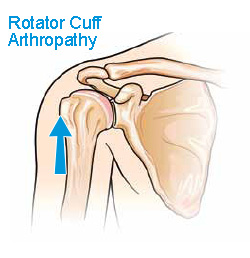

The Healthy Shoulder
The shoulder is a ball and socket joint that is made up mainly of two bones. The ball portion of the joint is part of the upper arm bone (humerus). The socket portion is part of the shoulder blade. The ball fits into the socket and is held in place by a series of muscles known as the rotator cuff, allowing the shoulder to move. In a healthy shoulder, this movement of ball and socket is painless.
Over time, wear and tear or injury to the shoulder can result in significant pain and loss of movement. Two common conditions that you may have been diagnosed with are:
- Rotator cuff arthropathy
- Osteoarthritis with cuff deficiency
Rotator Cuff Arthropathy
The rotator cuff is the group of muscles and tendons that hold the shoulder together, providing strength and stability. Rotator cuff arthropathy is a combination of two types of damage – not only has the cartilage deteriorated, the rotator cuff tendon that connects the muscle to the bone has also been severely worn or torn. This not only contributes to the pain, it may significantly limit the shoulder’s range of motion, making it impossible to perform many tasks requiring shoulder movement.
Osteoarthritis with Cuff Deficiency
In a healthy shoulder joint, the surface of the ball and socket bones are covered with a protective tissue called cartilage. The cartilage prevents the bones from making direct contact and allows them to move smoothly over each other, without friction or wear on the bone surfaces.
When that cartilage deteriorates due to wear and tear, it is called osteoarthritis. As osteoarthritis worsens, the bones rub against each other until they, too, begin to deteriorate. Throughout this progression of osteoarthritis, the pain gets worse and worse. Unfortunately, there is no medication or treatment that will make damaged cartilage grow back.
Treatments
Depending on the extent and cause of the shoulder damage, your orthopedic surgeon can recommend a variety of treatments, including oral medications, injections, physical therapy, and various surgical procedures. When those treatments are no longer effective, your doctor can help you determine if it’s time to consider reverse shoulder replacement surgery.
